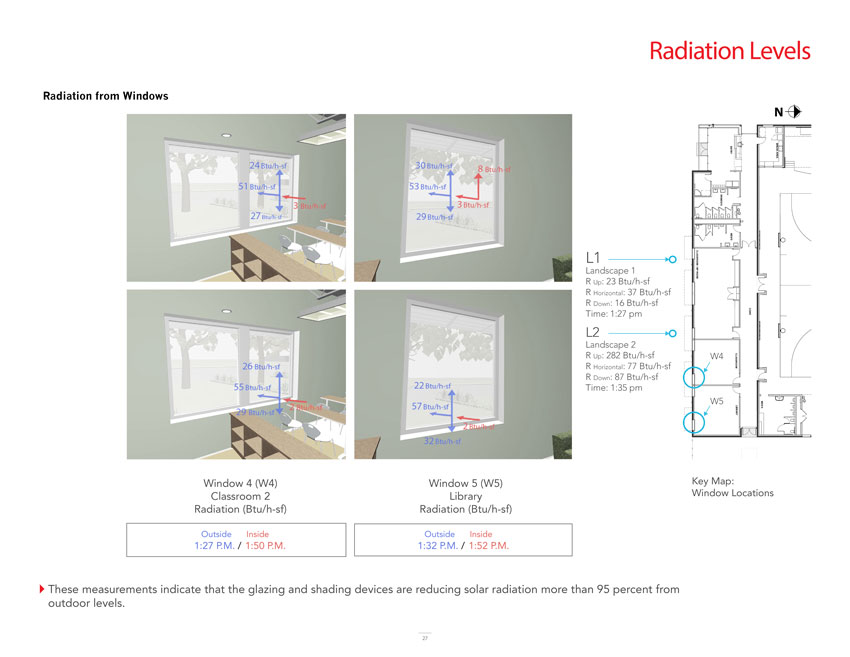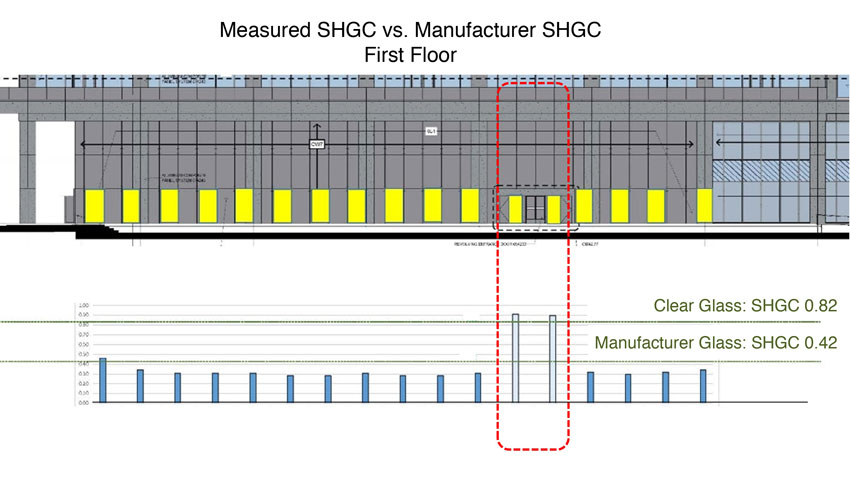Improving High-Performance Facades Through Post-Occupancy Evaluation
Leveraging that Knowledge
Once a POE is successfully performed, the next step is applying that information to the current design, where possible, and to future projects.
“This information gives insight into how satisfied the occupants are with the daylighting, glare, and thermal comfort aspects, how it impacts their work, and if adjustments need to be made for improvement,” says Thibaudeau. For example, “building owners can adjust the layout of furniture in spaces, add or change how internal shading works, and make adjustments to HVAC systems to improve comfort of occupants, especially near the perimeter. In a building with adequate daylight, adjustments can be made to reduce electric lighting.”
Delving into more details on how POEs can inform future daylighting designs, Thibaudeau explains that successful daylighting projects require thoughtful attention to how deep the daylight penetrates into a space; how to avoid bright spots, dark spots, and too much contrast; and assuring the ceiling and walls are lighted. “When the ceiling and walls are well-lit and the daylight is evenly distributed in the space, then the electric lights can be turned off, occupants are satisfied with the light levels, and predicted energy savings can be realized,” he explains.
However, in order to get to that point of success, lessons learned from POEs on other projects can go a long way toward fine-tuning those daylighting designs.
In Gowda’s experience, user feedback from POEs can reveal systematic issues related to facade performance and HVAC response time if there is thermal discomfort in areas of the building. “As building owners, operators, and managers become more service-oriented in competitive markets, POEs serve as a means of solving occupant concerns before they become broader issues,” she explains.
While issues related to building energy operations and indoor air quality can be costly to remedy, other mitigations related to certain aspects of health and wellness for building occupants may be leveraged more immediately, says Rohlfing. And depending upon what the enclosure issues are, acoustic and thermal remediation through films and where workers are positioned can be explored.
Similarly, Jauregui explains, “Although adding more insulation behind a facade may not be feasible at this point, there are things that can be caught and replaced, such as a broken seal in an insulated glass unit or a drainage issue that is resulting in unwanted moisture buildup.”
At the same time, because the facade is a static part of the building, Alec R. Carnes, PE, CEM, HBDP, LEED AP, building optimization practice leader, Heapy Engineering, Dayton, Ohio, points out that improving performance after construction is not easily accomplished since it typically would require opening the system for reworking.
That said, the other important aspect of POE “deliverables” are they key lessons learned for future high-performance projects.
“Design teams will have good predicted and actual performance metrics for enclosure U-value and infiltration rates that can be used as tolerances in future predictive energy modeling. Construction teams can identify numerous insights about their effectiveness of installation methodologies and procedures to ensure that future enclosures avoid faulty installation. And owners and operators can gain insight to comfort issues created by thermal performance, light quality, and acoustics associated with the enclosure,” says Rohlfing.
Capitalizing on the valuable data that POEs have to offer, Perkins Eastman has a database full of multiple past POEs that allows design teams to identify how high-performance facades are actually performing in relation to how they were designed and then tweak current facade designs accordingly.
For example, “measurement of glare, especially combined with occupant feedback on this issue, can help to make the case for more appropriate window-wall ratios and sun control mitigation,” explains Jana Silsby AIA, LEED AP, principal, Perkins Eastman, Boston. “Many clients and designers alike often adopt a position that more glass is always better. However, both qualitative and quantitative feedback from spaces where the glare and solar heat gain are not effectively controlled send a clear message that this is an important consideration for every design.”
Related to the window-to-wall ratio issue, Hendricks relates that her firm’s POEs often demonstrate that window assemblies designed with shading devices are, in fact, effectively reducing solar heat gain.

Image courtesy of Kirsky Architecture
Kirksy’s POE for the Burnett Bayland Gym reported that the glazing and shading designs are effectively reducing the outdoor solar radiation levels by more than 95 percent.
“Shading devices are expensive, and it can be difficult to persuade project teams that they are necessary. I’m glad to have measured results showing that our shading devices do work well,” she says.
In addition to helping architects and contractors with future facade projects, building owners can also leverage the POE insights garnered from their project to help with future decisions, for example, whether to go with a certain product or shading configuration the next time around.
POEs in Action
Taking a look at a few POE projects, Perkins Eastman evaluated the post-occupancy daylighting performance at Dunbar Senior High School in Washington, D.C.
Designed to achieve LEED daylight targets, the classroom was oriented east-west, appropriate shading was applied to the south facade, and ceilings were sloped to maximize daylight penetration into the interior.
Upon completing a POE, something quite interesting emerged: While the building was designed to meet LEED targets, in actuality, the space was considered slightly over-lit by building occupants.
Taking this valuable data to their next school project, Dr. Martin Luther King Jr. School in Cambridge, Massachusetts, Perkins Eastman reduced the window sizing and added an internal lightshelf to improve daylight distribution while minimizing glare.

Photos courtesy of Perkins Eastman
In Perkin Eastman’s POE for Dr. Martin Luther King Jr. School, 82 percent of the school staff reported satisfaction with the glare and visual comfort in the new school as compared to old swing spaces.
“Designing these classrooms to meet lower daylight targets actually resulted in classrooms that are almost entirely daylight autonomous—many teachers have never turned the electric lights on within their classrooms per our post-occupancy evaluations, and they feel no need to pull the blinds,” reports Jauregui.
Subsequently, the team also conducted some POE work at Martin Luther King. In particular, thermal imaging revealed some important information. Firstly, the storefront doors were significantly underperforming the rest of the storefront system and were a major contributor to heat loss in the winter.
“This information not only helped us report back to the manufacturer and discuss possible improvements that could be made to the product, but it also helped the design team realize the impact that expansive amounts of storefront doors could have on energy performance and limit that moving forward,” Jauregui explains.
Secondly, thermal imaging revealed that during installation, many of the inside corners on the project were left uninsulated as the corner detailing was not properly followed. “Through conversations with the contractor, we determined that the insulation was only installed directly behind the outside face of the brick, leaving a square gap at the inside corners,” she says. “This information has helped us to have specific conversations with the contractor and subcontractors to fix the existing problem and to ensure that future projects do not have this issue.”
Also using diagnostic equipment, in this case a solar radiation meter, part of Kirksy’s POE for Energy Center Three, a Houston headquarters building, measured the SHGC at select locations inside the curtain wall building with an approximate window-to-wall area ratio of 67 percent. In particular, the team took measurements on the east-facing, third-floor balcony where the low-E, double-glazed curtain wall windows were found to be performing in line with their manufactured value of 0.22.

Image courtesy of Kirksey Architects
As part of Kirsky’s POE for Energy Center One, the single-glazed balcony windows were found to be performing at their SHGC published value of 0.82, but the doors were only performing at 0.42. Although this was actually the doors’ SHGC published value, the discrepancy between the thermal performance levels was only realized through the POE.









